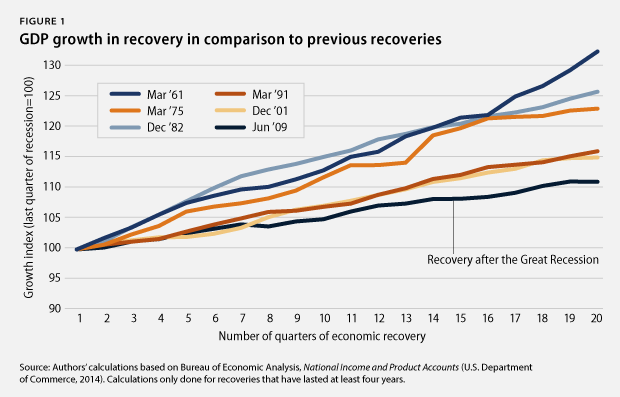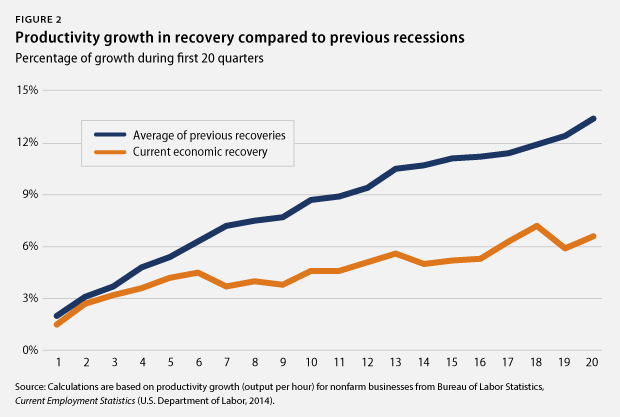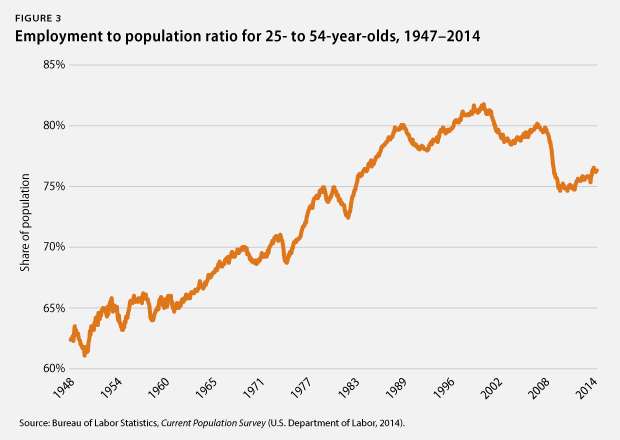Labor Day celebrates one of our country’s greatest attributes: the American worker. As the U.S. Department of Labor says, “It constitutes a yearly national tribute to the contributions workers have made to the strength, prosperity, and well-being of our country.” Despite slow but modest gains, this month’s economic data show that our current economy is still not working for American workers. Wages are stagnant, long-term unemployment is still high by historical standards, and poverty continues to be widespread. At the same time, five years after the end of the Great Recession, the very wealthy have seen substantial income gains due to a prolonged stock market rally built on high corporate profits that skyrocketed in the middle of the recession. While the nation’s wealthiest reap the benefits, America’s working class is left behind and face tremendous economic insecurity.
Our policies need to reflect the idea that with hard work comes economic security and opportunity. Policymakers need to implement policies that promote inclusive prosperity and economic mobility for all working families. Already, the president has taken steps to help workers. Through a series of executive actions, he has promoted responsible contracting by encouraging pay transparency, enforcing disclosure requirements that incentivize compliance with wage and workplace safety laws, and strengthening rules on employer retaliation. Yet these are only small victories in the fight to address a much larger problem.
As we approach the next legislative session, Congress needs to refocus its efforts on policies that help American workers, such as investing in innovation and infrastructure, expanding overtime rights, improving workplace flexibility, raising the minimum wage, and providing more opportunities to join unions. Congress needs to contribute its part to building an economy that works for everyone, not just the lucky few.
1. Despite modest gains, economic growth continues to lag behind previous recoveries. Economic growth lags behind similar points in prior business cycles. Gross domestic product, or GDP, increased in the second quarter of 2014 at an inflation-adjusted annual rate of 4 percent. Domestic consumption increased by an annual rate of 2.5 percent, and housing spending rose substantially by 9.5 percent, while business investment growth also increased at a rate of 5.5 percent. Exports increased by 9.5 percent in the first quarter, and government spending fell by 0.8 percent. The economy expanded by 10.3 percent from June 2009 to June 2014—its slowest expansion during recoveries of at least equal length. Policymakers need to strengthen growth, as the economy’s momentum is still too low to end the struggles of America’s middle class. Policies could include investments in infrastructure and education to overcome lackluster private business investments.

2. Improvements to U.S. competitiveness fall behind previous business cycles. Productivity growth, measured as the increase in inflation-adjusted output per hour, is key to increasing living standards, as it means that workers are getting better at doing more in the same amount of time. Slower productivity growth means that new economic resources available to improve living standards are growing more slowly than would be the case with faster productivity growth. U.S. productivity rose 6.6 percent from June 2009 to June 2014, the first 20 quarters of the economic recovery since the end of the Great Recession. This compares to an average of 13.4 percent during all previous recoveries of at least equal length. No previous recovery had lower productivity growth than the current one, and policymakers need to strengthen education, research and development, and infrastructure investments as important first steps to lay a foundation for faster future productivity growth.

3. The housing market continues to recover from historic lows. New-home sales amounted to an annual rate of 412,000 in July 2014—a 12.3 percent increase from the 367,000 homes sold in July 2013 but well below the historical average of 698,000 homes sold before the Great Recession. The median new-home price in July 2014 was $269,800, up from one year earlier. Existing-home sales were down by 4.3 percent in July 2014 from one year earlier, but the median price for existing homes was up by 4.9 percent during the same period. Home sales have to go a lot further, given that homeownership in the United States stood at 64.7 percent in the second quarter of 2014, down from 68.2 percent before the 2007 recession. The current homeownership rates are similar to those recorded in 1996, well before the most recent housing bubble started. A strong housing-market recovery can boost economic growth, and there is still plenty of room for the housing market to provide more stimulation to the economy more broadly than it did before the recent slowdown. The fledgling housing recovery could regain its strength if policymakers support policies that encourage faster income growth—such as a hike in the minimum wage—and have a greater emphasis on good jobs, such as an expansion of apprenticeships.
4. The outlook for federal budgets improves. The nonpartisan Congressional Budget Office, or CBO, estimated in July 2014 that the federal government will have a deficit—the difference between taxes and spending—of 3 percent of GDP for fiscal year 2014, which runs from October 1, 2013, to September 30, 2014. This deficit projection is down from 4.1 percent in FY 2013. This projected deficit for FY 2014 is slightly worse than what CBO predicted in March 2014, when it estimated a deficit of 2.8 percent of GDP for FY 2014. The estimated deficit for FY 2014 is much smaller than it was in previous years, due to a number of measures that policymakers have already taken to slow spending growth and raise a little more revenue than was expected just last year. The slowdown in health care costs—a result partially attributed to provisions within the ACA—has significantly contributed to these shrinking deficit projections. The improving fiscal outlook generates breathing room for policymakers to focus their attention on targeted, efficient policies that promote long-term growth and job creation as well as deficit reduction.
5. Moderate labor-market recovery shows less job growth than in previous business cycles. There were 8.1 million more jobs in July 2014 than in June 2009. The private sector added 8.7 million jobs during this period. The loss of some 554,000 state and local government jobs explains the difference between the net gain of all jobs and the private-sector gain in this period. Budget cuts reduced the number of teachers, bus drivers, firefighters, and police officers, among others. The total number of jobs has now grown by 6.2 percent during this recovery, compared to an average of 12.3 percent during all prior recoveries of at least equal length. Although employment has finally reached its prerecession peak, policymakers need to do much more to create jobs as Millennials—those born roughly between 1980 and 2000 and currently the largest generation of Americans—begin to reach working age.
6. Employment opportunities grow very slowly for people in their prime earning years. The employed share of the population from ages 25 to 54—which is unaffected by the aging of the overall population—was 76.7 percent in July 2014. This was just above the level recorded in June 2009 and well below the levels recorded since the mid-1980s and before the Great Recession started in 2007. The employed share of the population has, on average, grown by 3.2 percentage points at this stage during previous recoveries of at least equal length. Waiting for a healthy recovery simply is not enough to help workers. Policymakers need to step in to generate faster growth that can result in more jobs for all workers.

7. Employer-sponsored benefits disappear. The share of people with employer-sponsored health insurance dropped from 59.8 percent in 2007 to 54.9 percent in 2012, the most recent year for which data are available. The share of private-sector workers who participated in a retirement plan at work fell to 39.4 percent in 2012, down from 41.5 percent in 2007. Families now have less economic security than in the past due to fewer employment-based benefits, which requires them to have more private savings to make up the difference.
8. Some communities continue to struggle disproportionately from unemployment. The unemployment rate rose slightly to 6.2 percent in July 2014: The African American unemployment rate was 11.4 percent; the Hispanic unemployment rate remained the same at 7.8 percent; and the white unemployment rate also held steady at 5.3 percent. Meanwhile, youth unemployment fell to 20.2 percent. The unemployment rate for people without a high school diploma rose to 9.6 percent, compared with 6.1 percent for those with a high school degree, 5.3 percent for those with some college education, and 3.1 percent for those with a college degree. Population groups with higher unemployment rates have struggled disproportionately more amid the weak labor market than white workers, older workers, and workers with more education. Targeted policy interventions such as extended unemployment insurance benefits would offer much-needed help for some population groups, such as struggling youth and communities of color.
9. The rich continue to pull away from most Americans. Incomes of households in the 95th percentile—those with incomes of $191,000 in 2012, the most recent year for which data are available—were more than nine times the incomes of households in the 20th percentile, whose incomes were $20,599. This is the largest gap between the top 5 percent and the bottom 20 percent of households since the U.S. Census Bureau started keeping records in 1967. Median inflation-adjusted household income stood at $51,017 in 2012, its lowest level in inflation-adjusted dollars since 1995. And the poverty rate remains high—at 15 percent in 2012—as the economic slump continues to take a massive toll on the most vulnerable citizens. Higher minimum wages, an improved Earned Income Tax Credit and the closure of tax loopholes for the rich would be critical first steps for policymakers to address income inequality.
10. Corporate profits stay elevated near precrisis peaks. Inflation-adjusted corporate profits were 100 percent larger in March 2014 than in June 2009. The after-tax corporate profit rate—profits to total assets—stood at 3.4 percent in March 2014—higher than any profit rate recorded since September 1979. Corporate profits recovered quickly toward the end of the Great Recession and have stayed high since then. Addressing income inequality that arises from the rich receiving outsized benefits from their wealth through tax reform is a crucial policy priority.
11. Corporations spend much of their money to keep shareholders happy. From December 2007—when the Great Recession started—to December 2013, nonfinancial corporations spent, on average, 97 percent of their after-tax profits on dividend payouts and share repurchases. In short, almost all of nonfinancial corporate after-tax profits went to keep shareholders happy during the current business cycle. Nonfinancial corporations also held, on average, 5.3 percent of all of their assets in cash—the highest average share since the business cycle that ended in December 1969. Nonfinancial corporations spent, on average, 167 percent of their after-tax profits on capital expenditures or investments—by selling other assets and by borrowing. This was the lowest ratio since the business cycle that ended in 1960. U.S. corporations have prioritized keeping shareholders happy and building up cash over investments in structures and equipment, highlighting the need for regulatory reform that incentivizes corporations to invest in research and development, manufacturing plants and equipment, and workforce development.
12. Poverty is still widespread. The poverty rate remained flat at 15 percent in 2012—the most recent year for which data are available—which is an increase of 0.7 percentage points over the three years of the recovery, 2009 to 2012. The poverty rate has fallen, on average, by 0.7 percentage points in previous recoveries of at least equal length. Moreover, some population groups suffer from much higher poverty rate than others. The African American poverty rate, for instance, was 27.2 percent, and the Hispanic poverty rate was 25.6 percent, while the white poverty rate was 9.7 percent. The poverty rate for children under age 18 stood at 21.8 percent. More than one-third of African American children—37.9 percent—lived in poverty in 2012, compared with 33.8 percent of Hispanic children and 12.3 percent of white children. Strengthening economic security by adopting measures such as the Universal Savings Credit and the expansion of social safety net programs—such as SNAP and Medicaid—can help us reduce poverty and provide opportunities to Americans who need them most.
13. Household debt is still high. Household debt equaled 103.4 percent of after-tax income in March 2014, down from a peak of 129.7 percent in December 2007. A return to debt growth outpacing income growth, which was the case prior to the start of the Great Recession in 2007, from already-high debt levels could eventually slow economic growth again. This would be especially true if interest rates also rise from historically low levels due to a change in the Federal Reserve’s policies. Consumers would have to pay more for their debt, and they would have less money available for consumption and saving. Policymakers should therefore focus on creating high-quality jobs so that people do not need to borrow as much money as they did in the past and on regulatory reform to help millions of families avoid high and detrimental costs of credit.
Christian E. Weller is a Senior Fellow at the Center for American Progress and a professor in the Department of Public Policy and Public Affairs at the McCormack Graduate School of Policy and Global Studies at the University of Massachusetts, Boston. Jackie Odum is a Research Assistant for the Economic Policy team at the Center.